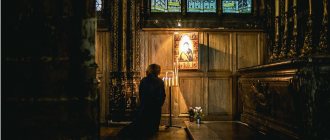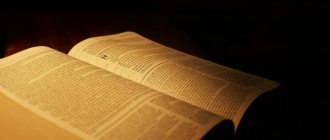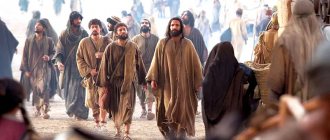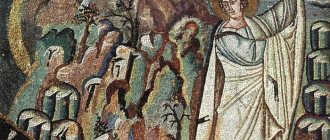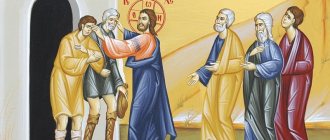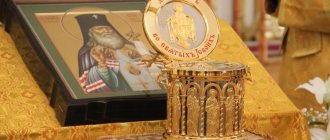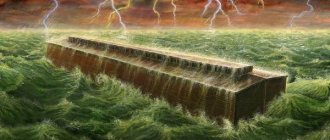Probably, many people have heard about such an event as the Lanchan miracle, but did not even delve into its essence and history. So, if we talk about the Lanci miracle in detail, then it’s worth saying right away that it happened back in the 8th century, in an Italian city called Lanciano. It was in this city, in the temple of San Legontius, that one priest, during the Sacrament of the Eucharist, was subject to doubts as to whether the Body and Blood of the Lord, hidden under the guise of bread and wine, were true. There is no exact mention of the name of this priest anywhere, but it was his obvious doubts that became the reason for the miracle described above, which Christians remember even now.
Lanchana Miracle of the Eucharist
The modern Orthodox Service Book, which contains instructions for priests, describes unforeseen cases when miracles can happen with bread and wine during the Eucharist.
The Miracle of Lancza is a historical fact of the transformation of bread and wine into human flesh and blood during the Eucharist.
The priest of the Italian church of San Legontius, located in the city of Lanciano, prepared for the Eucharist and constantly prayed, since he had the sin of disbelief that bread is the flesh of Christ, thereby denying Communion. The priest mentally asked God to show him the truth. The words of the Gospel were heard in the temple with fear and trembling.
And while they were eating, Jesus took bread, blessed it, broke it, and gave it to the disciples, saying, “Take, eat: this is My Body.” And, taking the cup and giving thanks, he gave it to them and said: drink from it, all of you, for this is My Blood of the New Testament, which is shed for many for the remission of sins. But I tell you that from now on I will not drink of this fruit of the vine until the day when I drink new wine with you in the kingdom of My Father.
During the breaking of bread, the temple was filled with the cry of the hieromonk, filled with amazement. Instead of bread, the priest held a piece of human flesh in his hands. Looking at the cup of wine, everyone in the temple witnessed the transformation of the wine into thick blood. The hieromonk, who had fallen into lack of faith, stood on his knees for a long time after the end of the Liturgy, repenting and asking for forgiveness, after which he thanked the Creator for the miracle revealed.
More about miracles:
- Barnaul miracle
- Shroud of Turin
- Miracles of the Descent of the Holy Fire
Similar cases are recorded in the history of the Church, but the transformations were temporary, flesh was again turned into bread, and blood into wine.
During the Lanchang miracle, the reverse transformation did not occur.
Miraculous blood placed in an antique bowl made from a single piece of rock crystal
Over time, the flesh turned into a hardened mass, and the blood coagulated into five balls, each of them weighing equal to the weight of all five. Even modern physics cannot explain this phenomenon.
Interesting! For 12 centuries, materialized flesh and blood have been stored in crystal vessels in the Temple of San Francesco, attracting pilgrims from all over the world.
Pan-Christian Miracle of Lanchan
The Lanchana miracle is a Eucharistic miracle recognized by the Catholic Church. According to church tradition, in the 8th century, during the Divine Liturgy, which was served in the church of the city of Lanciano, unleavened bread and wine turned into human flesh and blood.
Lanciano is a small ancient Italian town located 30 kilometers from the Pescara-Bari highway, which runs along the Adriatic Sea in the Abruzzo region.
The center of the city is a church once dedicated to Saint Longinus, the centurion who pierced the heart of the crucified Christ with his spear. Now this is the Church of St. Francis - that is its official name, but on all road signs in this city there is a duplicate name of the church - the Church of the Eucharistic Miracle (La chiesa del miracolo eucaristico)
Church of the Eucharistic Miracle (La chiesa del miracolo eucaristico)
This event took place in the 8th century AD, at a time when the Church of Christ was not yet divided into Catholic and Orthodox.
The sacrament of the Eucharist was celebrated in the Church of San Legontius in the ancient Italian city of Lanciano. But in the heart of one of the priests who served the Liturgy that day, doubt suddenly arose whether the Body and Blood of the Lord, hidden under the guise of bread and wine, were true. The doubt that arose in his soul became the cause of the Eucharistic miracle, which is still revered to this day.
This is what the throne looks like on which the miracle took place. Photos of our time
The priest drove away doubts, but they insistently returned again and again. “Why should I believe that bread ceases to be bread and wine becomes Blood? Who will prove this? Moreover, outwardly they do not change in any way and have never changed. Probably these are just symbols, just a memory of the Last Supper..."
“On the night when He was betrayed, He took bread... blessed it, broke it, and gave it to His disciples, saying: Take, taste: this is My Body, which is broken for you for the remission of sins. Likewise the cup, saying: Drink from it, all of you: this is My Blood of the New Testament, which is shed for you and for many for the remission of sins.”
The priest pronounced the holy words of the Eucharistic canon with fear, but doubts continued to torment him. Yes, He, the sacrificial Lamb, could by His Divine power turn wine into Blood, and bread into Flesh. He, who came by the will of the Heavenly Father, could do everything. But He left a long time ago, leaving this sinful world and giving it His holy words and His blessing as consolation... And, perhaps, His Flesh and Blood? But is this possible? Didn’t the true sacrament of communion go with Him to the heavenly world? Has the Holy Eucharist become just a ritual - and nothing more? The priest tried in vain to restore peace and faith in his soul.
Meanwhile, transubstantiation took place. With words of prayer, he broke the Eucharistic Bread, and then a cry of amazement filled the small church.
See also: How the human soul is represented in different religions
Under the fingers of the hieromonk, the broken Bread suddenly turned into something else - he did not immediately understand what exactly. And there was no longer wine in the cup - there was a thick scarlet Liquid, surprisingly similar to... blood. The stunned priest looked at the object in his hands: it was a thin slice of Flesh, reminiscent of the muscle tissue of the human body. The monks surrounded the priest, amazed by the miracle, unable to contain their amazement. And he confessed to them his doubts, which were resolved in such a miraculous way. Having finished the Holy Liturgy, he silently fell to his knees and plunged into long prayer. What did he pray for then? Did you ask for forgiveness for your lack of faith?..
In this cell the monk, the “culprit” of the miracle, began to repent
But one thing is truly known: since then, in the city of Lanciano, for twelve centuries, the miraculous Blood and Flesh, which materialized during the Eucharist in the Church of San Legontius (now San Francesco), have been preserved.
The body (above) and blood globules of the Savior (below). Lanciano
The news of the miracle quickly spread around the nearby cities and regions, and lines of pilgrims reached Lanciano.
Centuries passed and the miraculous Gifts became the object of attention of scientists. Since 1574, various experiments and observations have been carried out on the Holy Sacrament, and since the early 1970s they began to be carried out at an experimental level. But the data obtained by some scientists did not satisfy others.
Professor of the Faculty of Medicine of the University of Siena Odoardo Linoldi, a leading expert in the field of anatomy, pathological histology, chemistry and clinical microscopy, conducted research with his colleagues in November 1970 and March 1971 and came to the following conclusions. The Holy Sacrament, kept in Lanciano since the 8th century, represents authentic human flesh and blood. The flesh is a fragment of the muscle tissue of the heart; in cross-section it contains the myocardium, endocardium and vagus nerve. It is possible that the fragment of the Flesh also contains the left ventricle - this conclusion can be drawn from the significant thickness of the myocardium located in the tissues of the Flesh. Both Flesh and Blood belong to the same blood group: AB. This also includes the Blood found on the Shroud of Turin. Blood contains proteins and minerals in normal percentages for human blood. Scientists especially emphasized: what is most surprising is that Flesh and Blood has been preserved for twelve centuries under the influence of physical, atmospheric and biological agents without artificial protection or the use of special preservatives. In addition, Blood, being brought into a liquid state, remains suitable for transfusion, having all the properties of fresh blood. Ruggero Bertelli, professor of normal human anatomy at the University of Siena, carried out research in parallel with Odoardo Linoli and obtained the same results. In repeated experiments carried out in 1981 using more advanced equipment and taking into account new scientific advances in the field of anatomy and pathology, these results were again confirmed...
See also: 10 incredible theories about Jesus that will surprise even atheists
According to the testimony of contemporaries of the miracle, the materialized Blood later coagulated into five balls of different shapes, which then hardened. Interestingly, each of these balls, taken separately, weighs the same as all five together. This contradicts the elementary laws of physics, but this is a fact that scientists still cannot explain. In 1976, the WHO and UN medical commission published excerpts from their progress report, which, among other things, said that science, aware of its limitations, was stymied by the impossibility of providing any explanation. The last paragraph, of course, is not a statement of religious measure, but at least it is an apology for the humility that should be shown by one who devotes himself to scientific research.
Placed in an antique bowl made from a single piece of rock crystal, the miraculous Blood has been presented to the eyes of pilgrims and travelers visiting Lanciano for twelve centuries.
For us, 50 years, half a century, practically represents a whole life. Twelve centuries seem to us like an eternity, and perhaps it is with this sense of eternity that we “feel” the miracle of Lanciano, where the Lord allowed human science to verify His holy words: “This is my Body, this is the cup of my Blood, the New and Eternal Testament , the mystery of faith, shed for you and for many for the remission of sins.” When atheists claim: “Science has buried religion, the Church and prayer are obsolete,” the miracle at Lanciano decisively refutes all this. Science with its current capabilities proves the authenticity of the miracle! It is also intended for our time of unbelief, for, as the holy Apostle Paul says, miracles are performed not for believers, but for unbelievers. In our time, when some Christians doubt the true presence of Christ in the Eucharist, only science, recognizing the spiritual presence of Christ in the soul of the communicant, proves the evidence of the miracle. which has lasted for more than twelve centuries.
People of weak faith, who doubted or did not believe in the Eucharist, were given clear signs calling for conversion, for faith in the real presence of Jesus in the Eucharist.
Read below the impressions of a pilgrimage trip of a group of Orthodox Russian people to Christian places in Italy (a fragment of a narrative about a visit to Lanciano):
Day six. Lanciano
The last day of our trip. The first town we go to is Lanciano.
Lanciano became famous throughout the world because a miracle happened in the small church of St. Legonziano in the 8th century. One Greek monk (commentary - according to other links: Brazilian) performed the sacrament of the Eucharist and doubted the presence of the Lord during the performance of this sacrament. Immediately the bread became real Flesh, and the wine - real Blood. The Blood and Flesh of the Lord were preserved in this temple and have been preserved for 12 centuries in the main altar of the Church of St. Francis, built over the ancient temple of the holy martyr Legontian.
See also: Paintings of the Sistine Chapel
The temple also bears the second and main name - Eucharistic miracle
We enter the temple and approach the main altar, where behind the glass there is a reliquary with the Body and Blood of Christ. Sometimes an Orthodox person, finding himself among many Catholics, does not feel very confident. So we, constrained by the beginning of the Mass, felt timid. Suddenly a short man stood in front of us and led us into a small room behind the throne with a window, so that we saw the reliquary with the Body and Blood literally a meter away from us. Orthodox icons hung in this room, and this led us to the idea that this room was just for us.
After we prayed, the same man took us downstairs, where the ancient church of the martyr Legontian was preserved, in which the Eucharistic miracle took place. Quite a small room. We walked along a corridor recently excavated by archaeologists. High on the wall hung an icon of the Crucifixion of Jesus Christ, which somehow miraculously managed to survive for many centuries, buried under the thickness of the earth.
Father Sylvester talks about the Miracle
At the end we went to an exhibition where it was described what scientific research was carried out with the Body and Blood. The body turned out to be a real human heart, and five balls of dried blood represent a double miracle in Lanciano. The fact is that when one ball of blood was weighed, it weighed one gram, when two balls were weighed, they also weighed one gram, and when all five balls were weighed, they still weighed one gram. Such a miracle is proven by the fact that when we receive communion, we receive the whole of Christ, and not part of Him.
Struck by what we saw and heard, we said goodbye to our guide and left the temple.
source
27.02.2008
If you find an error, please select a piece of text and press Ctrl+Enter.
What science says about the Lanchan miracle
The Lanchang miracle excites the minds of scientists around the world to this day. Research is carried out by chemists, physicists, microbiologists, pathologists and many other specialists.
Only in 1971 did scientists prove that real Holy Gifts are stored in crystal glasses:
- the pieces of flesh were identified as a piece of the left ventricle of the heart;
- The balls consist of group 4 blood. The same group was discovered on the Shroud of Turin.
Experts have confirmed the possibility of preservation of flesh and blood for 12 centuries. It's hard to believe, but scientists say that blood can be diluted to a liquid state and still be suitable for transfusion.
Holy Sacrament (Lanciano, Italy)
Ten years later, other specialists, using more modern equipment, conducted new studies that confirmed the previously obtained results.
Attitude to the Lanchan miracle in Orthodoxy
Photo: Bravedefender.ru
If we talk about the attitude of Orthodoxy to the Lanchan miracle, then there is no unambiguous attitude. This miracle is not depicted in any way on Christian holidays, but the holy fathers described similar cases more than once. Most often, such transformations occurred when the priest did not have enough faith, but then the flesh again became ordinary bread, and the blood in the cup became wine.
The miracle that happened in an Italian town is a fact that has been proven scientifically, so it can be accepted or not accepted, but cannot be refuted.
As the Apostle Paul said, the Lord does not show His miracles for believers, but specifically for those who do not believe or have not yet been strengthened in their faith, in order to help them find the truth. The incident described above was able to confirm that in the Eucharist Christians truly receive the Blood and Body of Christ.
